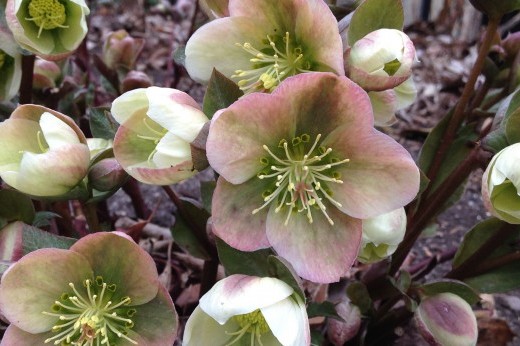During social gatherings, when the conversation drifts in the direction of work, people are often curious about my job as a gardener. One question in particular comes up fairly often: “What do you do in the winter?”
You might be wondering the same thing—you clicked on this article, after all. So what have BBG’s gardeners been up to in the “off-season?”
Well, we garden. Gardening encompasses many different activities; not all of them can be done in the winter (for example, if the ground is frozen, we’re not planting anything), but a lot of them can. The Conservatory gardeners and other indoor Horticulture staff are often watering, growing, propagating, and caring for plants throughout the winter season, but outdoor gardeners are surprisingly busy, too.
Winter—even one as unusually mild as this year's—is full of sensory delights. The rattle of a wind-shaken seed pod while I prune a nearby shrub. The citrusy scent of the witch-hazel blooms as I cut back perennials. The glitter of the sun as it filters through the needles of a pine while I spread mulch. Below, I’ve explored some of the tasks you might find the outdoor gardeners at Brooklyn Botanic Garden engaged in during the winter months.
Pruning
If you stroll through the garden on a winter day, you may see us pruning trees or summer-flowering deciduous shrubs like hydrangeas, beautyberry, or winterberry holly. You might catch the rose gardener pruning the climbing roses, or the Osborne gardener pruning the wisteria that grows over the pergolas. Winter is a great time to prune deciduous climbing plants because you get such a clear view of your cuts when the branches are bare.
One of my favorite jobs in the winter is pruning the climbing hydrangea in the Rock Garden. It’s so satisfying to make the pruning cuts that reveal the powerful bare trunk that winds around the rocks.
Cutting Back
We cut back the dead stalks, leaves, and flower heads from herbaceous perennials, usually all the way to the ground. We do this mostly for aesthetic reasons, though there can be practical motivations, too, like managing the weight of biomass on the Visitor Center’s green roof. Although seed heads have visual appeal and can benefit the animals in the Garden, they can look a little ragged by midwinter. When the plants put out new growth in the spring, it appears more dramatic if the old, dead plant parts are not distracting from the show.
Timing cutback can be complicated, because we are always balancing the needs of the plants and the ecosystems they inhabit with our need to present a showy display to visitors. We recommend home gardeners delay cutting back as long as possible, but because of the volume of work we have here at Brooklyn Botanic Garden, we usually cut back in the winter whenever the weather is warm enough to work outside.
Gardeners can cut dead plant parts any time of year, but winter or early spring is a good time because most plants are dormant, so we’re less likely to accidentally cut any new growth. Some plants break dormancy before spring, so we take extra care when cutting back those plants to avoid impacting the new growth.
Mulching
We mulch in the winter to make the beds look neat and tidy for the spring. The mulch also suppresses the growth of weeds, which can make the spring gardening season more manageable. Gardeners use different types of mulch depending on the cultural needs of the area they are mulching and their aesthetic preferences. Most gardeners at BBG use shredded wood for mulch, but some use leaf mold, straw, or pine needles.
Research, Planning, and Ordering
Brooklyn Botanic Garden is a pretty special place to work because we’re not just gardeners, we are also the curators of our areas. Every winter we research suitable plants for our areas. We give a great deal of thought to which plants to add to our collections. We pore over books and catalogs and attend conferences for inspiration, talk with each other to share ideas, and get excited about our plans for the upcoming season. After researching, we order plants and seeds. We also use this time to order tools and other supplies so we’re all ready for spring.
Shoveling Snow
Though it hasn’t happened much this year, if it just snowed, you’ll see us shoveling and plowing. The gardeners remove the snow to make the Garden safe for visitors after a snowfall. We use plows and brushes attached to our vehicles for the roads, and snow blowers and shovels for the smaller areas the trucks can’t access.
Keeping Records
As a scientific institution, our plant records are very important. The gardeners are responsible for keeping records of the plants in our areas. We enter all new plants into our plant records database, and also record any losses.
Adding plants to our database is called “accessioning,” and removing plants is called “deaccessioning.” In addition, we note if a plant has increased in number—if a plant reproduces, for example, or gets divided—or if they’ve decreased (for example, if one or more plants in a group have died). If we have transplanted something, we record the change of location. We update our plant records all year round, but winter is a good time to make sure the records are up to date.
Organizing and Sharpening
Gardeners have areas to maintain beyond the areas visible to visitors. We have tools to sharpen, storage areas to clean and organize, and files and books to tidy. These spaces can get a little unruly during the hustle and bustle of the growing season and we use the winter (especially the colder days) to restore order.
Although winter is a time of dormancy for much of Brooklyn Botanic Garden, the gardeners continue our work, keeping the Garden healthy and beautiful so it’s ready to flourish when the spring comes.



